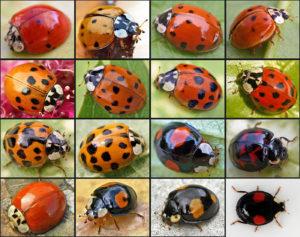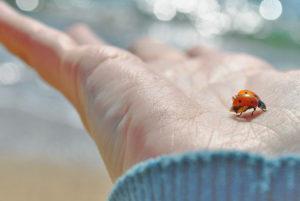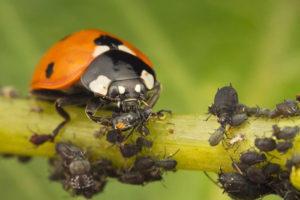Ladybugs: the legendary bugs and their true nature
“Ladybug, fly to the sky, where your children eat sweets ...”. Sometimes they eat cutlets, distribute them to everyone except dogs, or bring bread. The bright ladybug bugs are familiar to everyone since childhood. The characters of this positive counting rhyme are actually great helpers of agriculture.
Content
Description of ladybug
Name: Ladybugs or coccinellids
Latin:coccinellidaeClass: Insects - Insecta
Squad: Coleoptera - Coleoptera
 | Habitats: | everywhere except Antarctica |
 | Dangerous for: | aphids and small insects |
 | Means of destruction: | usually do not need adjustment |
Ladybugs are a family of coccinellidae beetles. They are round or oval, most often brightly colored with spots. These are common predators that are ubiquitous.
About a hundred representatives of a large family live on the territory of Russia. They are not found only beyond the Arctic Circle and in permafrost conditions.
The structure of the beetle
The size of the "sun" varies depending on the type of animal. They range from 0,8 to 18 mm, but are most commonly 4-8 mm. They look very bright.
- the shape of the body is round-oval;
- convex on top, flat bottom;
- surface of body glabrous, sometimes slightly covered with hairs;
- small head;
- large eyes;
- movable antennae of different lengths;
- massive jaws and oral apparatus of a sucking type;
- rounded decorated elytra;
- legs developed, covered with hair.
Life cycle
Ladybug beetles, or simply suns, go through a full life cycle of four stages.
People believed that the number of spots depends on the age of the bug. But actually the points depend on the view. Determine the age of the insect only the definition of the stage of the life cycle will help.
Eggs
The female lays 5 to 30 eggs at a time. She places them on the back of the leaf, close to the food source. In one clutch there are also unfertilized eggs, which will subsequently be food for the emerging larvae.
Larvae
Larvae appear 2-10 days after laying. More precisely, this period will depend on the characteristics of the climate. They look very unusual, like small alligators. The body of the larva is elongated, tuberous, dark in color with bright stripes or spots.
At the larval stage, ladybugs are very voracious. They eat aphids, scale insects, mites, eggs of various insects. They are promiscuous and may eat unhatched eggs.
They go through the stages of growing up until the moment they pass into the pupal stage. They are accompanied by molts.
Pupae
The larva attaches to the leaf when it is ready to pupate. They become motionless, yellow-orange. In this stage, the ladybug is up to 15 days and, with biochemical processes, becomes a full-fledged amazing bug.
Adults
Adults have a soft exoskeleton and a pale color. They have a shade for some time and become dense. They survive low temperatures in large clusters. They hibernate under bark or rocks. The life span is not more than 2 years.
Distribution and habitation
There are more than 8000 species of ladybugs in total. They are found ubiquitously on plants:
- trees;
- herbs;
- shrubs;
- reeds;
- water;
- flowers.
What does the name say
Such an unusual name was taken for a reason. A respectful attitude suggests that the animal enjoys sympathy. He is called the Sun, the beetle of the Virgin Mary, the red-bearded grandfather.
The history and other variants of the name of the beetle is here.
Nutrition of the sun and its enemies
Small-looking beetles are different almost brutal appetite. They destroy a large number of predators. Moreover, adults and larvae eat a lot:
- aphid;
- ticks;
- caterpillars;
- scale insects;
- eggs of Colorado beetles;
- butterfly eggs.
In turn, the ladybugs themselves are perfectly protected from pests by their bright color. In the animal kingdom, it is known that a bright color is evidence of unsuitability for food. They also have a liquid that is secreted for self-defense.
Enemies at the ladybug Hardly ever. They are only eaten by hedgehogs and praying mantises. The dinocampus insect is a parasite. It lays eggs in the beetle's body and eats it from the inside.
Types and groups of ladybugs
Depending on their dietary preferences, ladybugs are divided into several groups.
- Aphidophages that prefer aphids.
- Coccidophages, lovers of worms and scale insects.
- Acariphagi that eat ticks.
- Mixoentomophages, picky predators.
- Phytophages, eaters of plant foods.
Types of ladybugs


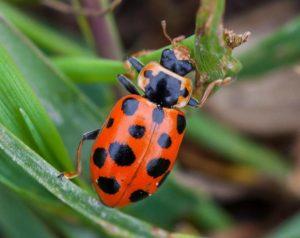
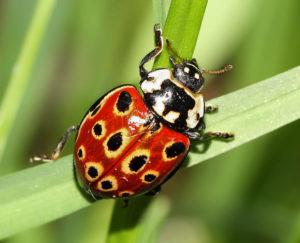
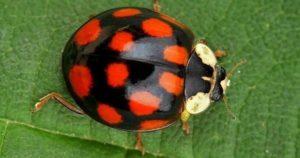
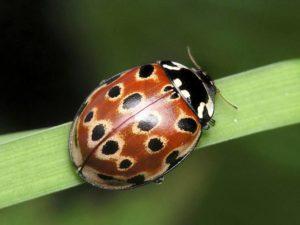

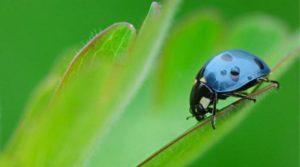
Benefit and harm
A small beetle is of great benefit. Eating a huge amount of pests, they help with them in the fight. There are also special farms where these insects are grown and can be purchased if necessary.
In the 19th century, in the United States, a grooved mealybug hunted on citrus fruits, and it massively destroyed plantations. To solve this problem, it was decided to have a ladybug Rhodolia, which successfully coped with the task.
It is worth noting a few important points that you should be wary of.
- Asian ladybug showing aggression can bite a person.
- A large crowd can disturb people.
- The liquid that they secrete for self-defense causes allergies.
- Beetles carry ticks and a number of infections.
- Some are pests.
- Exist spider and ladybug insect.
Attracting ladybugs
On the site, an excess of this species of animals is a problem, but gardeners are convinced that a few individuals should definitely live there. Poisons that are used to kill pests also harm beneficial animals.
You can lure ladybugs:
- Food, or rather aphids, which loves red elderberry very much.
- Planting flowering plants. These are dandelions, umbrella, angelica.
- Feeding them with pollen, artificially spraying it.
- Using pheromone baits.
Unusual facts about ladybugs
This creature is endowed with some kind of magical power and energy. There are many signs associated with them. And those who believe in omens take care of the bugs.
- Ladybug is a herald of change for the better.
- In the house during the cold weather, a ladybug is considered a blessing.
- The sun on the hand - to fulfill a dream, on clothes - to good luck.
Ladybugs were even considered messengers from heaven. They could predict the weather. If they quickly flew away from the hand, it will be sunny and clear, and when the beetle is in no hurry, the weather will change.
https://youtu.be/0l_4gs3t2_M
A few bad stories
The ladybug's reputation as a cute bug is not entirely deserved. For example, they are completely promiscuous in sexual relations. The clutch may contain eggs fertilized by several males at once. And sexually transmitted diseases are normal for them.
Harmless at first glance, beetles have a tendency to cannibalism. With a lack of nutrition, they eat their own eggs and even small larvae. Therefore, they are careful - if the aphid colony already has a clutch, ladybugs will choose another place.
Often, in the process of indiscriminate group communication, ladybugs pass on pests to each other. One compact beetle can carry up to 80 ticks on its own body. And infection reduces the immunity of the animal and the quality of eggs.
Some ladybugs, in the absence of food, move to berries, fruits and grapes. There are cases when whole barrels of wine spoiled because there were bugs in the grains that spoiled the taste by releasing their protective substance.
Conclusion
Cute suns are actually active and voracious predators. They eat a lot of aphids and other soft-shelled insects. But it is better not to rush to pick them up for hygiene and safety purposes.
Previous